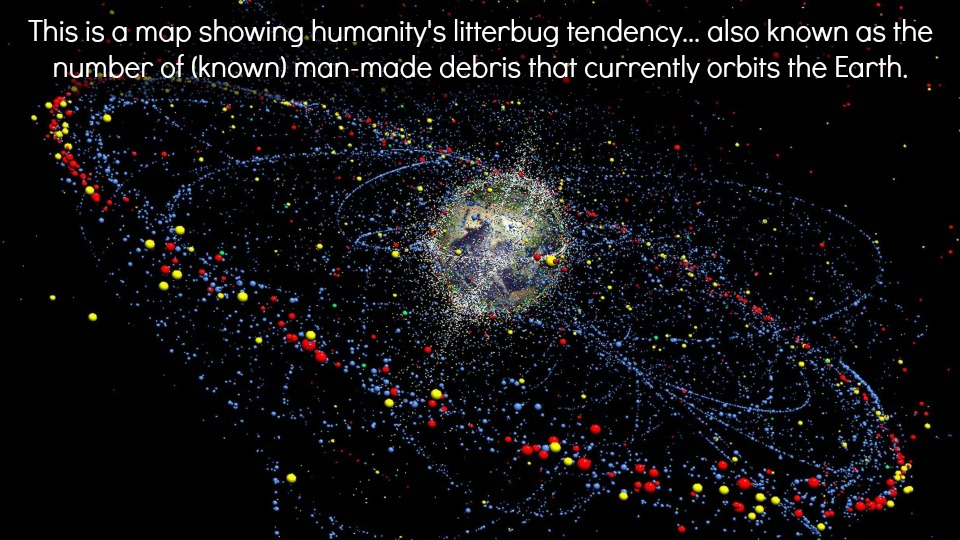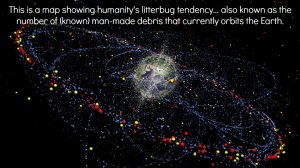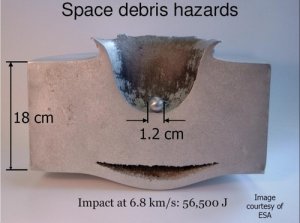

Question: So, what’s the plan long-term to deal with space trash? We truly have no idea what the long term ramifications of our junk might be. So wouldn’t it be far more responsible to have a plan now rather than react to the effects of our garbage? Is anyone doing anything about this? just wondering…
Asked by Kristen Herrington
Answer: It seems like when man hits a new frontier there is a pattern to how history plays out. They boldly go where no man has gone before, they realize the big mess they’re making, and then finds a way to clean it up. Kind of like a cook who doesn’t clean up as they go. Yes, you might have made a delicious meal, but you also made a monstrous mess.
Space is no different. There are a number of different ways we’ve managed to clutter space, from the inexperience of the first space programs, to human error, to objects breaking up (either intentionally or by collision) in orbit. In the 70 (or so) years of our interactions with space, that clutter as accumulated and now is on the verge of being a real issue, at according to a study done by the National Research Council (NRC). This tipping point is known as the Kessler Syndrome (or Kessler Effect).

The Kessler Syndrome is a scenario thought up by NASA scientist Donald J. Kessler in which the density of objects in low Earth orbit (LEO) is high enough that collisions between these objects would cause a cascade. Each collision would generate more debris, which increases the chance of collision, and it continues in this deadly loop until LEO is a warzone. One of the implications of this cascade is that space exploration and the use of satellites could be unfeasible for many generations.
Currently, the estimation objects larger than 10 centimeters in diameter debris in LEO is 21,000, approximately 500,000 object particles between 1-10 centimeters, and about 100 million debris particles smaller that 1 centimeter. All of which are racing around the planet at approximately 8 kilometers per second (greater than 17,000 miles an hour – a 1-ounce object traveling at that speed has the same kinetic energy of a 2ston car traveling at 60 miles per hour).
So, what can we do? There are currently a number of ideas on the subject of how to clean up our space junk which include, but are not limited to: zapping it with lasers, automated robots, tethers, big/small space tugs, and dust clouds. I’ll explain the lasers and the dust cloud here since these methods, in my opinion, seem the most practical for the immediate future, and the automated robots for longevity.

The laser method doesn’t really eliminate the problem rather than postpone it. In this scenario, as space junk approaches a valuable asset, a ground based laser fires at the debris, which nudges it into a different orbit. Hooray, crisis averted… For now that is. The problem with this method is it doesn’t actually remove the debris, instead, it just moves the debris into a different orbit thus prolonging (but briefly stabilizing) the problem.
The man-made dust cloud would involve putting a large, dense clouds of small particulate matter into LEO. As debris passed through this cloud the friction would cause the debris to slow down and fall back to Earth. The main issue here is money. Whereas this method has the potential to remove many of the larger objects in orbit, it’ll be expensive to make it happen.
Finally, in the future it is possible that we will have a network of robots in orbit removing debris as it accumulates. We actually already have the technology to start going down that road, but again it would be a very expensive undertaking.

One thing is for certain, with so many countries entering the spacefaring club; space debris is going to turn into a very serious problem. Hopefully, the spacefaring nations of the world will get together and do something about it before it is too late.